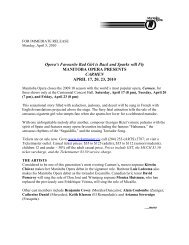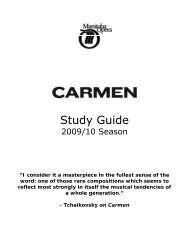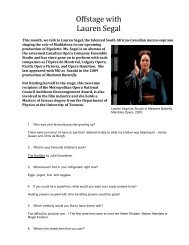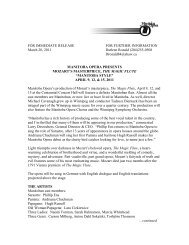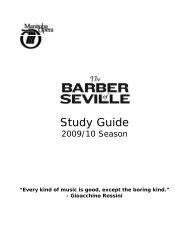La Traviata Study Guide - Manitoba Opera
La Traviata Study Guide - Manitoba Opera
La Traviata Study Guide - Manitoba Opera
Create successful ePaper yourself
Turn your PDF publications into a flip-book with our unique Google optimized e-Paper software.
Designer - a production can have two or three designers: a lighting designer, a costume designer,<br />
a set designer, or someone who is both costume and set designer. They work closely with the<br />
stage director to give the production a distinctive look.<br />
Director - guides the production from rehearsal through to stage performances and is involved in<br />
every word, structure, and how the opera will ‘live’ on the stage. Tom Diamond is the director of<br />
<strong>La</strong> <strong>Traviata</strong>.<br />
Diva - literally, “goddess” in Italian. An important female opera star. The masculine form is<br />
divo.<br />
Dramaturge - acts as a sounding board or story editor for the writer and helps maintain the<br />
dramatic structure.<br />
Dress Rehearsal - the final rehearsal before opening night, includes costumes, lights, makeup,<br />
etc. Sometimes it is necessary to stop for adjustments, but an attempt is made to make it as much<br />
like a regular performance as possible.<br />
Duet - music that is written for two people to sing together.<br />
Encore - a piece that is performed after the last scheduled piece of a concert. An encore is<br />
usually performed because the audience wants to hear more music even though the concert is<br />
over.<br />
Ensemble - a part of the opera written for a group of two or more singers. This may or may not<br />
include the chorus.<br />
Falsetto - the upper part of a voice in which the vocal cords do not vibrate completely. Usually<br />
used by males to imitate a female voice.<br />
Finale - the last musical number of an opera or an act.<br />
Grand <strong>Opera</strong> - spectacular French opera of the Romantic period, lavishly staged, with a<br />
historically based plot, a huge cast, an unusually large orchestra, and ballet. It also refers to opera<br />
without spoken dialogue.<br />
Helden - German prefix meaning “heroic.” Can also apply to other voices, but usually used in<br />
“heldentenor.”<br />
House - the auditorium and front of the theatre excluding the stage and backstage areas.<br />
Impresario - the proprietor, manager, or conductor of an opera or concert company; one who<br />
puts on or sponsors an entertainment; manager, producer.<br />
Interlude - a short piece of instrumental music played between scenes and acts.<br />
Intermission - a break between acts of an opera. The lights go on and the audience is free to<br />
move around.<br />
Librettist - the writer of the opera’s text. The librettist for <strong>La</strong> <strong>Traviata</strong> is Francesco Maria Piave.<br />
Libretto - Italian for “little book.” It is the text or story of the opera.<br />
Lyric - used to describe a light to medium weight voice with an innocent quality, capable of both<br />
sustained, forceful singing and delicate effects.<br />
Maestro - means “master” in Italian. Used as a courtesy title for the conductor (male or female).<br />
Mark - to sing, but not at full voice. A full-length opera is very hard on a singer’s voice so most<br />
performers mark during rehearsals.<br />
Mezzo-soprano - the middle singing range for a female voice. Colleen Skull (Flora) is an<br />
example of this singing voice.<br />
Motif or Leitmotif - a recurring musical theme used to identify an emotion, person, place, or<br />
object.<br />
<strong>Opera</strong> - a dramatic presentation which is set to music. Almost all of it is sung, and the orchestra<br />
is an equal partner with the singers. Like a play, an opera is acted on stage with costumes,<br />
scenery, makeup, etc. <strong>Opera</strong> is the plural form of the <strong>La</strong>tin word opus, which means “work.”<br />
<strong>Opera</strong> buffa (Italian)- an opera about ordinary people, usually, but not always comic. First<br />
developed in the eighteenth century.<br />
19



